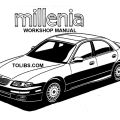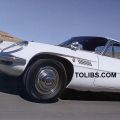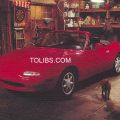An Album of Mazda’s Rotary Engine Vehicles
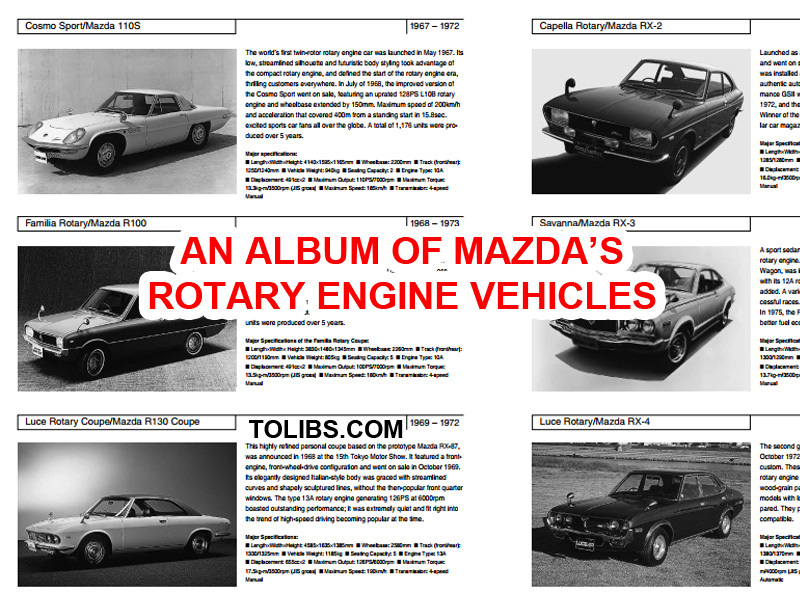
All Mazda’s Rotary Engine Vehicles
Mazda has been known for its dedication to the rotary engine, but the technology faced challenges such as fuel efficiency and emissions. As of my last update, Mazda had been exploring ways to revive the rotary engine, particularly in the context of a hybrid powertrain. The RX-Vision concept, showcased in 2015, hinted at the possibility of a future rotary-powered sports car.
All Mazda Rotary Car Listed:
Cosmo Sport/Mazda 110S (1967 - 1972)
The world’s first twin-rotor rotary engine car was launched in May 1967. Its low, streamlined silhouette and futuristic body styling took advantage of the compact rotary engine, and defined the start of the rotary engine era, thrilling customers everywhere. In July of 1968, the improved version of the Cosmo Sport went on sale, featuring an uprated 128PS L10B rotary engine and wheelbase extended by 150mm. Maximum speed of 200km/h and acceleration that covered 400m from a standing start in 15.8sec. excited sports car fans all over the globe. A total of 1,176 units were produced over 5 years.
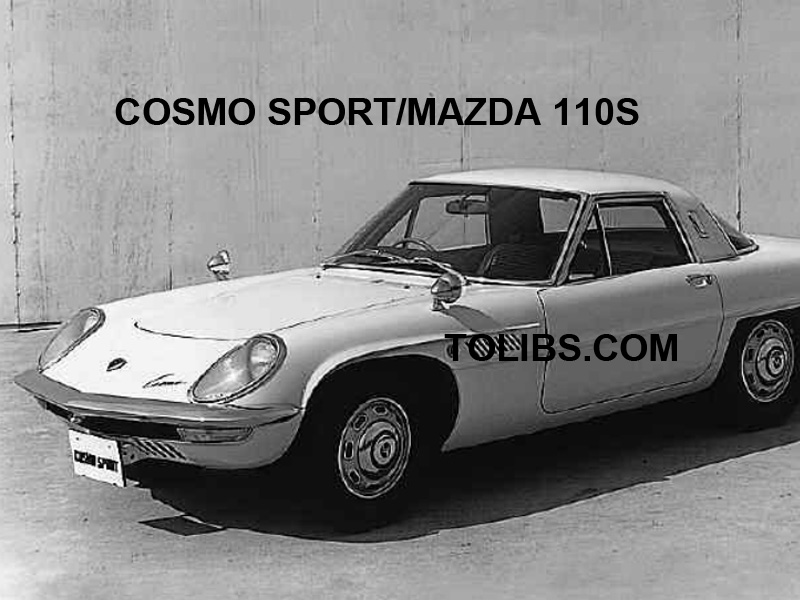
Major Specifications of the Cosmo Sport Mazda 110S:
- Length × Width × Height: 4140 × 1595 × 1165mm
- Wheelbase: 2200mm
- Track (front/rear): 1250/1240mm
- Vehicle Weight: 940kg
- Seating Capacity: 2
- Engine Type: 10A
- Displacement: 491cc×2
- Maximum Output: 110PS/7000rpm
- Maximum Torque: 13.3kg-m/3500rpm (JIS gross)
- Maximum Speed: 185km/h
- Transmission: 4-speedManual
Capella Rotary/Mazda RX-2 (1970 - 1978)
Launched as a high-performance model in the mid-sized Capella series and went on sale in May 1970. A newly designed rotary engine, the 12A, was installed and the G series, the world’s first rotary engine car with authentic automatic transmission, was added in 1971. The high-performance GSII with its 5-speed manual transmission, was introduced in 1972, and the AP, with its full anti-pollution package, came out in 1974. Winner of the 1972 Import Car-of-the-Year award from Road Test, a popular car magazine in the U.S. at the time.
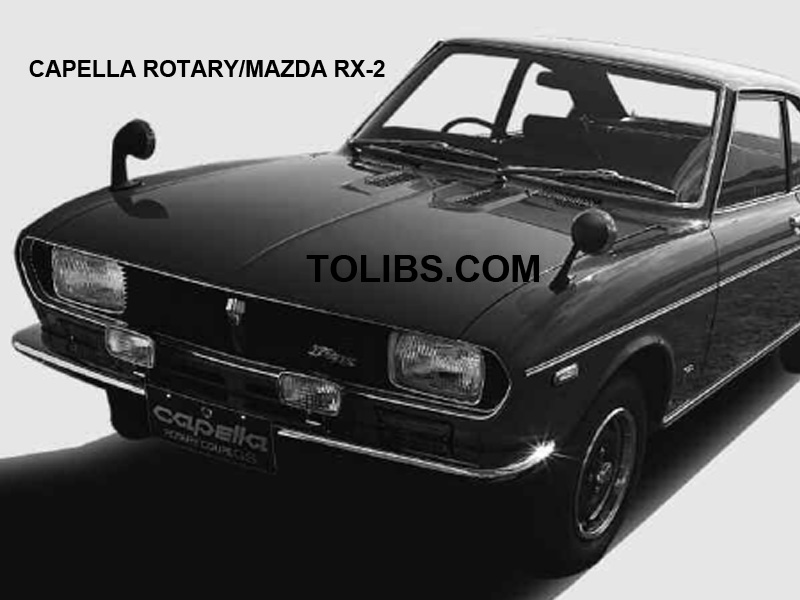
Major Specifications of the Capella Rotary Coupe:
- Length × Width × Height: 4150 × 1580 × 1395mm
- Wheelbase: 2470mm
- Track (front/rear): 1285/1280mm
- Vehicle Weight: 950kg
- Seating Capacity: 5
- Engine Type: 12A
- Displacement: 573cc×2
- Maximum Output: 120PS/6500rpm
- Maximum Torque: 16.0kg-m/3500rpm (JIS gross)
- Maximum Speed: 190km/h
- Transmission: 4-speed Manual
Familia Rotary/Mazda R100 (1968 - 1973)
Development was based on the prototype Mazda RX-85, announced in 1967 at the 14th Tokyo Motor Show. It went on sale in July, 1968. The type 10A rotary engine, proven to be reliable and durable in the Cosmo Sport, was mounted in a fastback, two-door coupe style body designed as a high performance touring car, but with sufficient space to be used as a family car. In 1969, the sedan version-a high-performance family car called the Familia Rotary SS-was added to the lineup. A total of 95,891 units were produced over 5 years.
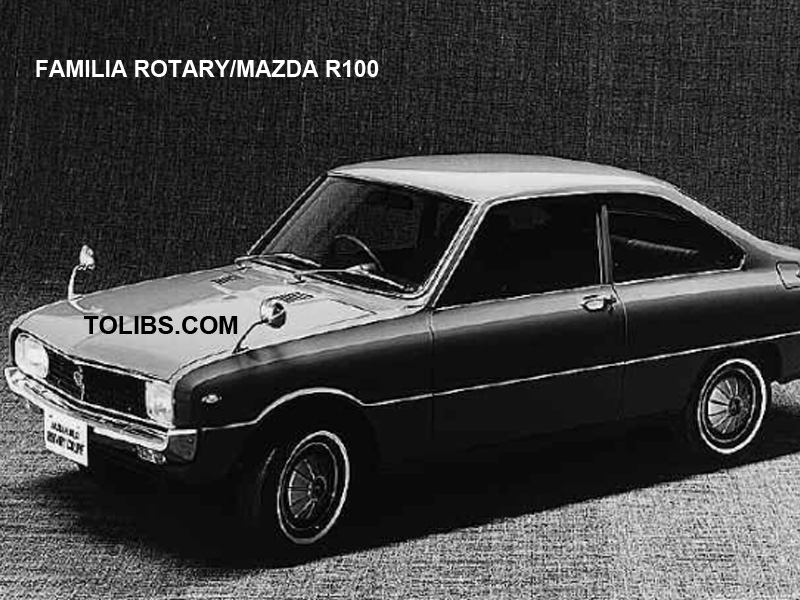
Major Specifications of the Familia Rotary Coupe:
- Length × Width × Height: 3830 × 1480 × 1345mm
- Wheelbase: 2260mm
- Track (front/rear): 1200/1190mm
- Vehicle Weight: 805kg
- Seating Capacity: 5
- Engine Type: 10A
- Displacement: 491cc×2
- Maximum Output: 100PS/7000rpm
- Maximum Torque: 13.5kg-m/3500rpm (JIS gross)
- Maximum Speed: 180km/h
- Transmission: 4-speed Manual
Savanna/Mazda RX-3 (1971 - 1978)
A sport sedan and coupe launched in September 1971, with the type 10A rotary engine. In 1972 the fully automatic transmission version, the Sport Wagon, was introduced as the world’s first rotary engine wagon. The GT, with its 12A rotary engine and 5-speed manual transmission, was also added. A variety of sport-kits were prepared and contributed to many successful races. In 1973, the AP, with its anti-pollution package, was added. In 1975, the REAPS rotary engine, which achieved lower emissions and better fuel economy, was introduced.
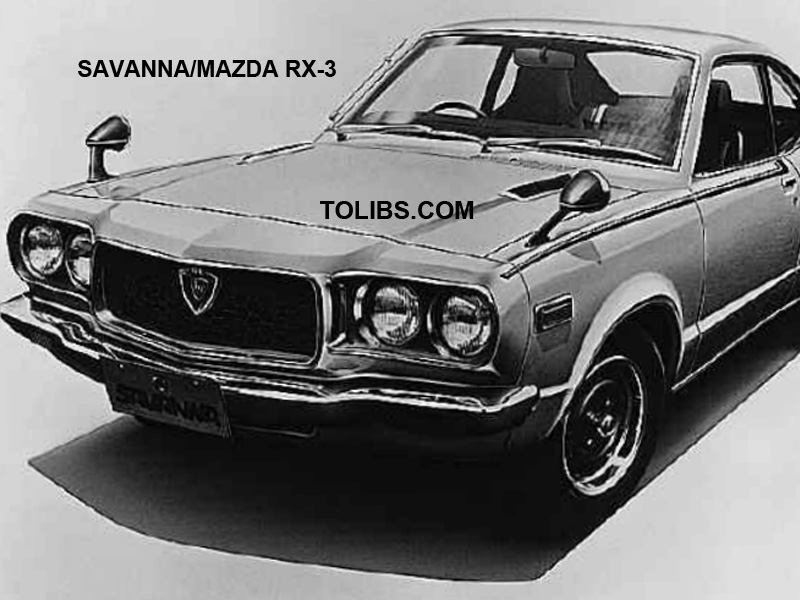
Major Specifications of the Savanna Coupe:
- Length × Width × Height: 4065 × 1595 × 1350mm
- Wheelbase: 2310mm
- Track (front/rear): 1300/1290mm
- Vehicle Weight: 875kg
- Seating Capacity: 5
- Engine Type: 10A
- Displacement: 491cc×2
- Maximum Output: 105PS/7000rpm
- Maximum Torque: 13.7kg-m/3500rpm (JIS gross)
- Maximum Speed: 175km/h
- Transmission: 4-speed Manual
Luce Rotary Coupe/Mazda R130 Coupe (1969 - 1972)
This highly refined personal coupe based on the prototype Mazda RX-87, was announced in 1968 at the 15th Tokyo Motor Show. It featured a frontengine, front-wheel-drive configuration and went on sale in October 1969. Its elegantly designed Italian-style body was graced with streamlined curves and shapely sculptured lines, without the then-popular front quarter windows. The type 13A rotary engine generating 126PS at 6000rpm boasted outstanding performance; it was extremely quiet and fit right into the trend of high-speed driving becoming popular at the time.

Major Specifications of the Luce Rotary Coupe/Mazda R130 Coupe:
- Length × Width × Height: 4585 × 1635 × 1385mm
- Wheelbase: 2580mm
- Track (front/rear): 1330/1325mm
- Vehicle Weight: 1185kg
- Seating Capacity: 5
- Engine Type: 13A
- Displacement: 655cc×2
- Maximum Output: 126PS/6000rpm
- Maximum Torque: 17.5kg-m/3500rpm (JIS gross)
- Maximum Speed: 190km/h
- Transmission: 4-speed Manual
Luce Rotary/Mazda RX-4 (1972 - 1977)
The second generation Luce, with its 12A rotary engine, was launched in October 1972 and was available in three body styles: hardtop, sedan, and custom. These models led the way into the top sport & luxury markets for rotary engine cars. In 1973, the Luce Wagon and the Grand Turismo with wood-grain panels on the sides, were added. At the same time, additional models with low emission AP versions and 13B rotary engines were prepared. They proved that low emissions and high performance could be compatible.
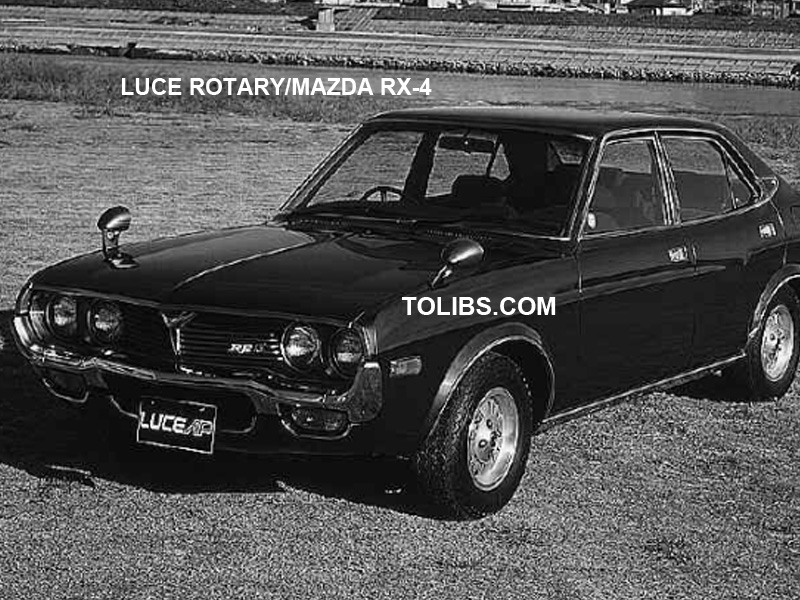
Major Specifications of the Luce Sedan:
- Length × Width × Height: 4240 × 1670 × 1410mm
- Wheelbase: 2510mm
- Track (front/rear): 1380/1370mm
- Vehicle Weight: 1035kg
- Seating Capacity: 5
- Engine Type: 12A
- Displacement: 573cc×2
- Max. Output: 130PS/7000rpm
- Max. Torque: 16.5kgm/4000rpm (JIS gross)
- Max. Speed: 185km/h
- Transmission: 5-speed Manual/3-speed Automatic
Mazda Rotary Pickup (1973 - 1977)
Marketed exclusively in North America where pick-up trucks enjoyed great popularity, this was the world’s first pick-up truck and utility vehicle with a rotary engine. The lightweight and compact rotary engine was durable and fit well in this type of vehicle. Massive front grill, boxy body, large mirrors, extruded fenders, and wide tires were well-suited to the tastes of American pickup buyers. This was a unique rotary engine vehicle, not sold in Japan.
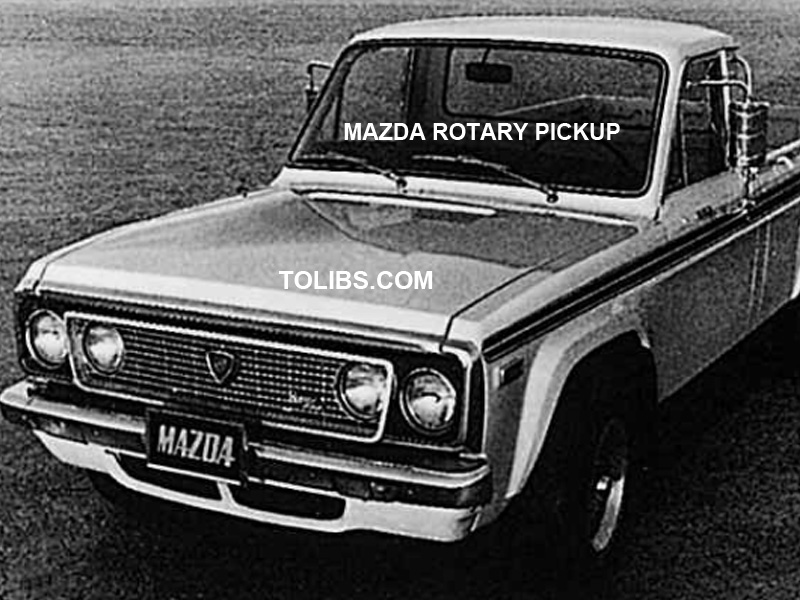
Major Specifications of the Mazda Rotary Pickup:
Not available, vehicle marketed exclusively in North America.
Parkway Rotary 26 (1974 - 1976)
The world’s first rotary engine bus, launched in July 1974 and equipped with the 135PS maximum power 13B rotary engine, offered a cruising speed of 120km/h with a pleasantly smooth ride, low noise and little vibration, thanks to the inherent benefits of the rotary engine. Two models were available: a 26-passenger Deluxe version with optional air-conditioning operated by a sub-engine, and the 13-passenger Super-Deluxe version, with full luxury equipment. This was a unique model that showed the rotary engine was not solely for passenger cars.
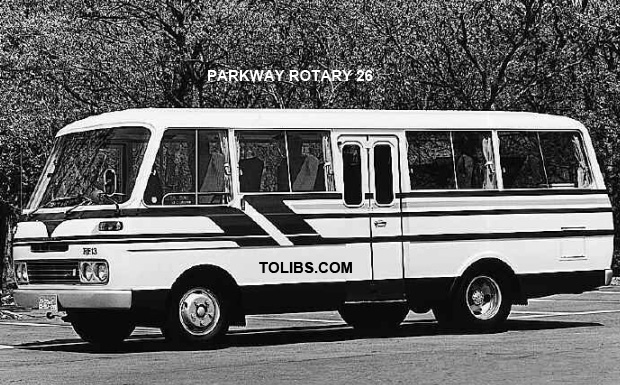
Major Specifications of the Parkway Rotary 26:
- Length × Width × Height: 6195 × 1980 × 2290mm
- Wheelbase: 3285mm
- Track (front/rear): 1525/1470mm
- Vehicle Weight: 2885kg
- Seating Capacity: 26
- Engine Type: 13B
- Displacement: 654cc×2
- Maximum Output: 135PS/6500rpm
- Maximum Torque: 18.3kg-m/4000rpm (JIS gross)
- Maximum Speed: 120km/h
- Transmission: 4-speed Manual
Luce Legato/Mazda 929L (1977 - 1981)
Launched in October 1977 as the top of the Luce series. The Luce Legato’s development concepts were high quality, grace, and distinction. Two rotary engine options, type 13B with 135PS and 12A with 125PS, were available. Two body styles, the 4-door Pillared Hardtop and the 4-door Sedan, were also offered. To meet various market segments, Mazda offered 3 versions and 10 types for the Pillared Hardtop, 4 versions and 10 types for the Sedan, and 3 types (with manual, automatic, and columnshift automatic transmission) for the top version, the 13B-powered Limited.
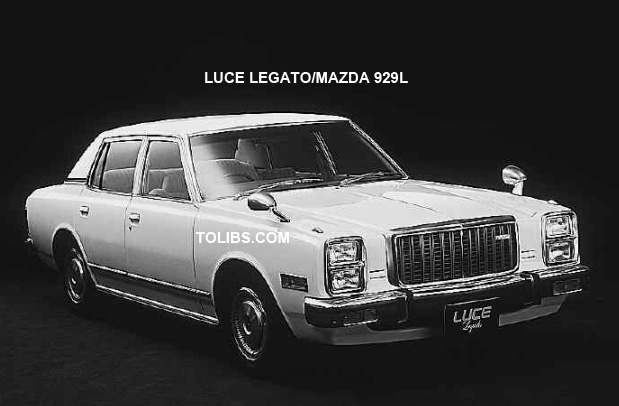
Major Specifications of the Luce Legato 4-door Hardtop:
- Length × Width × Height: 4625 × 1690 × 1385mm
- Wheelbase: 2610mm
- Track (front/rear): 1430/1400mm
- Vehicle Weight: 1225kg
- Seating Capacity: 5
- Engine Type: 13B
- Displacement: 654cc×2
- Maximum Output: 135PS/6000rpm
- Maximum Torque: 19.0kg-m/4000rpm (JIS gross)
- Transmission: 5-speed Manual/3-speed Automatic
Mazda Roadpacer AP (1975 - 1977)
A full-size sedan launched in March 1975, with some body parts and mechanical components supplied by GM-Holden of Australia. The engine was Mazda’s 13B RE. Anticipating the era of international joint operations, this project aimed at lowering costs and raising quality through shortened development periods; it saved its tooling investment for the small-volume, premium market. The Roadpacer AP was mainly sold as a chauffeur-driven saloon for company executives, but was also attractive as a highclass personal car. 800 units were produced over three years.
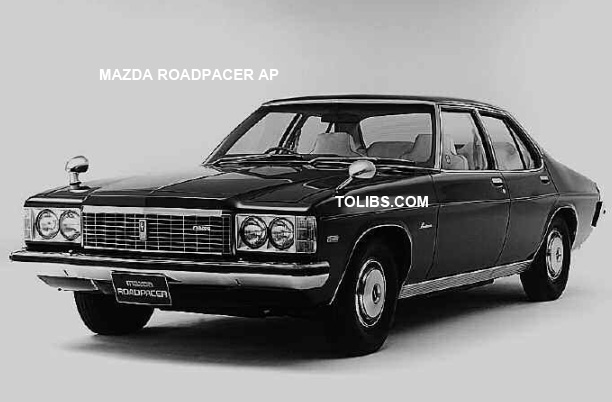
Major Specifications of the Mazda Roadpacer AP:
- Length × Width × Height: 4850 × 1885 × 1465mm
- Wheelbase: 2830mm
- Track (front/rear): 1530/1530mm
- Vehicle Weight: 1575kg
- Seating Capacity: 5
- Engine Type: 13B
- Displacement: 654cc×2
- Maximum Output: 135PS/6000rpm
- Maximum Torque: 19.0kg-m/4000rpm (JIS gross)
- Maximum Speed: 165km/h
- Transmission: 3-speed Automatic
Savanna RX-7/Mazda RX-7 (1978 - 1985)
The first generation RX-7 was launched in March 1978. The front mid-ship layout with an improved 12A engine and the then-unique retractable headlights helped realized an aerodynamic body design. This model became extremely popular not only in Japan but also in North America. A face-lift was made in 1980, the new 6PI engine was installed in 1981, and the 12A turbo rotary engine, which developed 165PS added in 1983.
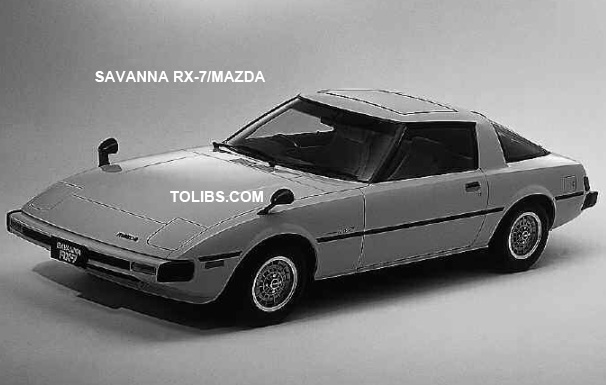
Major Specifications of the Savanna RX-7/Mazda RX-7:
- Length × Width × Height: 4285 × 1675 × 1260mm
- Wheelbase: 2420mm
- Track (front/rear): 1420/1400mm
- Vehicle Weight: 1005kg
- Seating Capacity: 4
- Engine Type: 12A
- Displacement: 573cc×2
- Maximum Output: 130PS/7000rpm
- Maximum Torque: 16.5kg-m/4000rpm (JIS gross)
- Transmission: 5-speed Manual/3-speed Automatic
Mazda Cosmo 2-door Hardtop (1981 - 1990)
The third-generation Cosmo, launched in October 1981, was developed as a high-end personal car to meet the requirements of the day. Three body variations were offered: 2-door and 4-door hardtops, and saloon. The 6PI type 12A rotary engine was originally installed; type 13B, with its electronically controlled super-injection system, and type 12A with the Impact-Turbo, the world’s first turbo rotary engine, were added later. Equipped with four-wheel independent and electronically controlled suspension, the Cosmo was fast and a pure pleasure to drive.
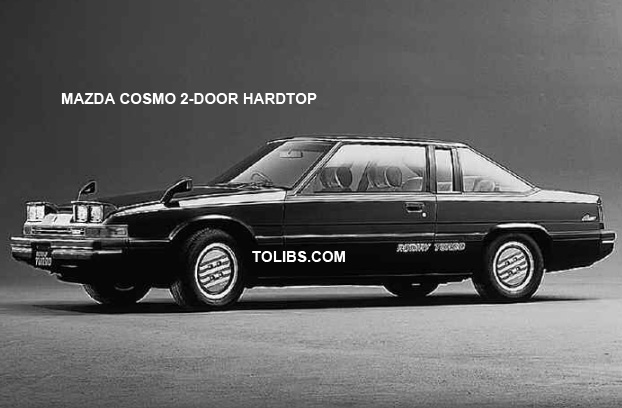
Major Specifications of the Cosmo 2-door Hardtop:
- Length × Width × Height: 4640 × 1690 × 1340mm
- Wheelbase: 2615mm
- Track (front/rear): 1430/1425mm
- Vehicle Weight: 1170kg
- Seating Capacity: 5
- Engine Type: 12A
- Displacement: 573cc×2
- Maximum Output: 130PS/7000rpm
- Maximum Torque: 16.5kg-m/4000rpm (JIS gross)
- Transmission: 5-speed Manual/3-speed Automatic
Mazda Luce (1986 - 1991)
The fifth-generation Luce, launched in September 1986, was designed to couple the luxury of the top-end sedan with the sportiness of the rotary engine. The powerful turbocharged 13B rotary engine, with its 180PS maximum power, was installed. Combined with a newly developed automatic transmission, it realized smoother and quicker acceleration. The highly rigid monocoque body featured struts for the front and Mazda’s unique E(Multi)-link suspension for the rear. It thus resulted in a high level of compatibility between performance and comfort as a luxury saloon.
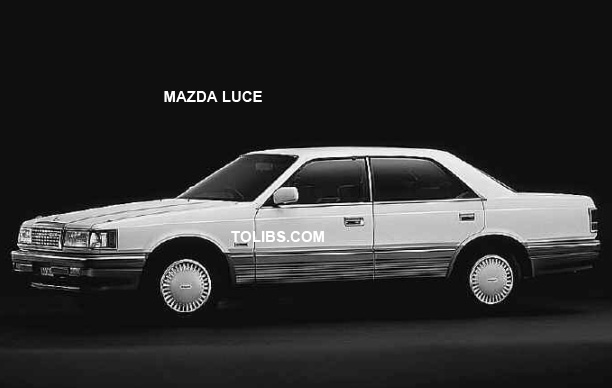
Major Specifications of the Mazda Luce:
- Length × Width × Height: 4690 × 1695 × 1395mm
- Wheelbase: 2710mm
- Track (front/rear): 1440/1450mm
- Vehicle Weight: 1500kg
- Seating Capacity: 5
- Engine Type: 13B turbo
- Displacement: 654cc×2
- Maximum Output: 180PS/6500rpm
- Maximum Torque: 25.0kg-m/3500rpm
- Transmission: 4-speed Automatic
Luce/Mazda 929 (1981 - 1986)
The 3rd generation Luce was launched in October 1981, at the same time as the Cosmo. The series included a 4-door sedan and a hardtop, powered by a 2.0-liter reciprocating or a 12A rotary engine. Like the Cosmo, the rotary engine model employed Mazda’s first 4-wheel independent suspension system. Later, the Luce underwent a major face-lift and got an extensively modified nose and rear end. The new top range models, powered by a turbochaged 12A or dynamic supercharger-equipped 13B rotary engine, became popular in the market as a luxury car with performance and elegance.
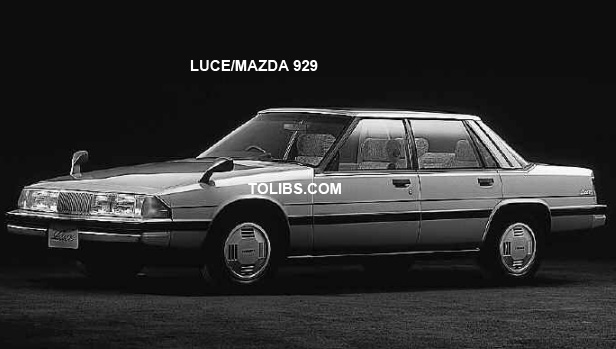
Major Specifications of the Luce 4-door Hardtop:
- Length × Width × Height: 4640 × 1690 × 1360mm
- Wheelbase: 2615mm
- Track (front/rear): 1430/1420mm
- Vehicle Weight: 1165kg
- Seating Capacity: 5
- Engine Type: 12A
- Displacement: 573cc×2
- Maximum Output: 130PS/7000rpm
- Maximum Torque: 16.5kg-m/4000rpm (JIS gross)
- Transmission: 5-speed Manual/3-speed Automatic
Mazda Eunos Cosmo (1990 - 1995)
The Eunos Cosmo, launched in April 1990, was the world’s first seriesproduction car with a 3-rotor rotary engine, the type 20B-REW with Sequential Twin Turbo system, developing maximum power of 280PS in a smooth and responsive manner. The body was exclusively designed for the “full-size” category in Japan, The cabin was spaced as a luxury 2 plus 2, and interior materials-leather and wood-were carefully selected at the raw material stage. The engine, suspension automatic transmission, and air-conditioning system were all electronically controlled.
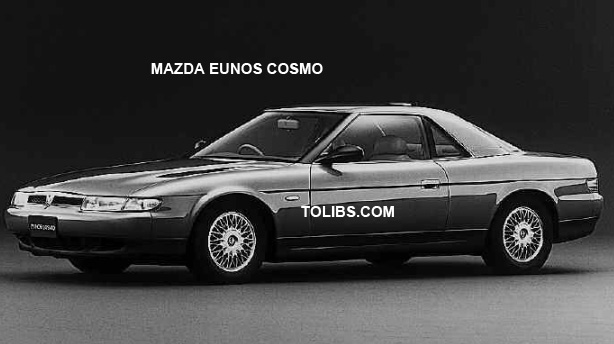
Major Specifications of the Mazda Eunos Cosmo:
- Length × Width × Height: 4815 × 1795 × 1305mm
- Wheelbase: 2750mm
- Track (front/rear): 1520/1510mm
- Vehicle Weight: 1610kg
- Seating Capacity: 4
- Engine Type: 20B-REW
- Displacement: 654cc×2
- Maximum Output: 280PS/6500rpm
- Maximum Torque: 41.0kg-m/3000rpm (JIS net)
- Transmission: 4-speed Automatic
Savanna RX-7/Mazda RX-7 (1985 - 1992)
The second-generation RX-7 was launched in October 1985, with further upgraded styling and dynamic performance. The 13B rotary engine with Twin-Scroll Turbo and intercooler developed maximum power of 185PS. Mazda’s unique multi-link rear suspension with toe-control capability also came as standard. The interior was designed with a perfect blend of harmony, beauty, and sportiness; the result was a “matured” sports car. In 1987, the Cabriolet was added; in 1989, the engine’s maximum output was raised to 205PS.
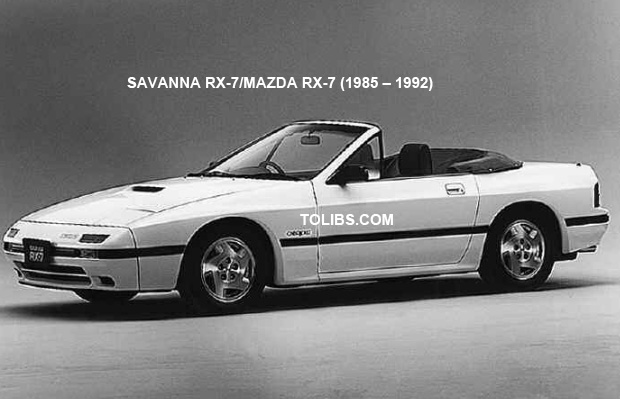
Major Specifications of the Savanna RX-7/Mazda RX-7 (1985 – 1992):
- Length × Width × Height: 4310 × 1690 × 1270mm
- Wheelbase: 2430mm
- Track (front/rear): 1450/1440mm
- Vehicle Weight: 1240kg
- Seating Capacity: 4
- Engine Type: 13B turbo
- Displacement: 654cc×2
- Maximum Output: 185ps/6500rpm
- Maximum Torque: 25.0kgm/3500rpm (JIS net)
- Transmission: 5-speed Manual/4-speed Automatic
Mazda RX-7 (1991 - 2002)
The third-generation RX-7, launched in December 1991, featured a powerful and responsive 13B-REW rotary engine with Sequential Twin-Turbo and a superbly beautiful body silhouette. All-wheel double-wishbone suspension with newly developed dynamic geometry control mechanism was standard on all models. Developed as a pure sports car, it pursued the ultimate in driving pleasure. Face lifts came in 1996 and in 1998, and the maximum output of the 13B REW was boosted to 280PS for enhanced sports-car pleasure.
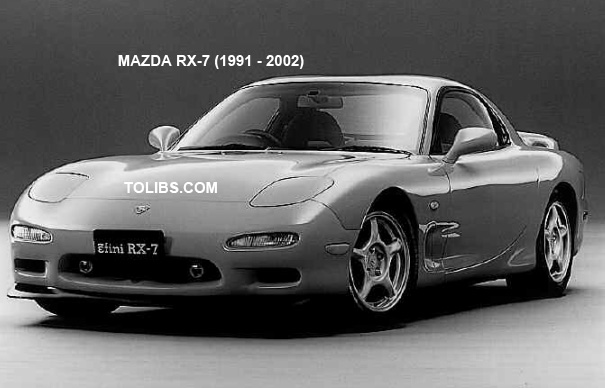
Major Specifications of the Mazda RX-7 (1991 – 2002):
- Length × Width × Height: 4295 × 1760 × 1230mm
- Wheelbase: 2425mm
- Track (front/rear): 1460/1460mm
- Vehicle Weight: 1250kg
- Seating Capacity: 4
- Engine Type: 13B-REW
- Displacement: 654cc×2
- Maximum Output: 255PS/6500rpm
- Maximum Torque: 30.0kg-m/5000rpm (JIS net)
- Transmission: 5-speed Manual/4-speed Automatic
Mazda RX-8 (2003 - present)
The RX-8, which debuted in April 2003, comes equipped with the new-generation RENESIS rotary engine. Though naturally aspirated, the new RENESIS maximizes the benefits of the rotary engine, while being more compact, lighter and higher performing than its predecessors. It also provides more cabin space, accommodating up to four adults in comfort. The RX-8 is a 4-door, 4-seat sports car with innovative styling. As a new-concept genuine sports car with high levels of environmental and safety performance, the RX-8 has garnered many awards, including the 2004 RJC Car of the Year Award, and enjoys considerable popularity among the car-buying public.

Mazda RX-8 Hydrogen RE (2004 - present)
The hydrogen-fuelled RX-8 Hydrogen RE started running on public roads in Japan on receiving approval from the Ministry of Land, Infrastructure and Transport in October 2004. With zero CO2 emissions, the hydrogen rotary engine exhibits exceptional environmental performance while retaining the characteristic-driving feel of an internal combustion engine. To enable the RX-8 Hydrogen RE to run in areas not yet provided with hydrogen filling stations, the engine uses a dual-fuel system that switches between hydrogen and gasoline fuel modes. The base model RX-8 remains unchanged, assuring seating capacity for four as well as highly practical on-board equipment. The RX-8 Hydrogen RE, which is leased to businesses and local governments, is gaining a favourable reputation and spurring research and development towards the realization of a hydrogen energy society.
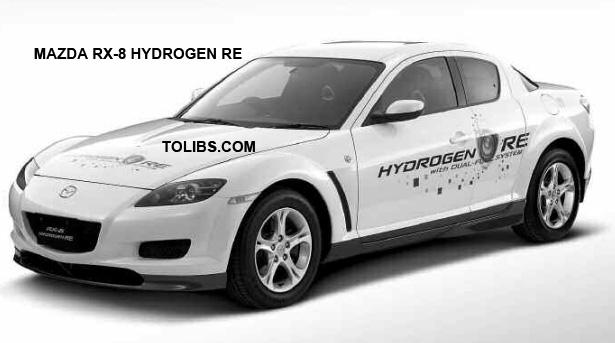
Major Specifications of the Mazda RX-8 Hydrogen RE:
- Length × Width × Height: 4435 × 1770 × 1340mm
- Wheelbase: 2700mm
- Track (front/rear): 1500/1505mm
- Vehicle Weight: 1460kg
- Seating Capacity: 4
- Engine Type: 13B
- Displacement: 654cc×2
- Maximum Output (Net): Hydrogen 109PS, Gasoline 210PS
- Maximum Torque (Net): Hydrogen 14.3kg-m, Gasoline 22.6kg-m
- Transmission: 4-speed Automatic
- Fuel: Hydrogen/gasoline dual-fuel system

